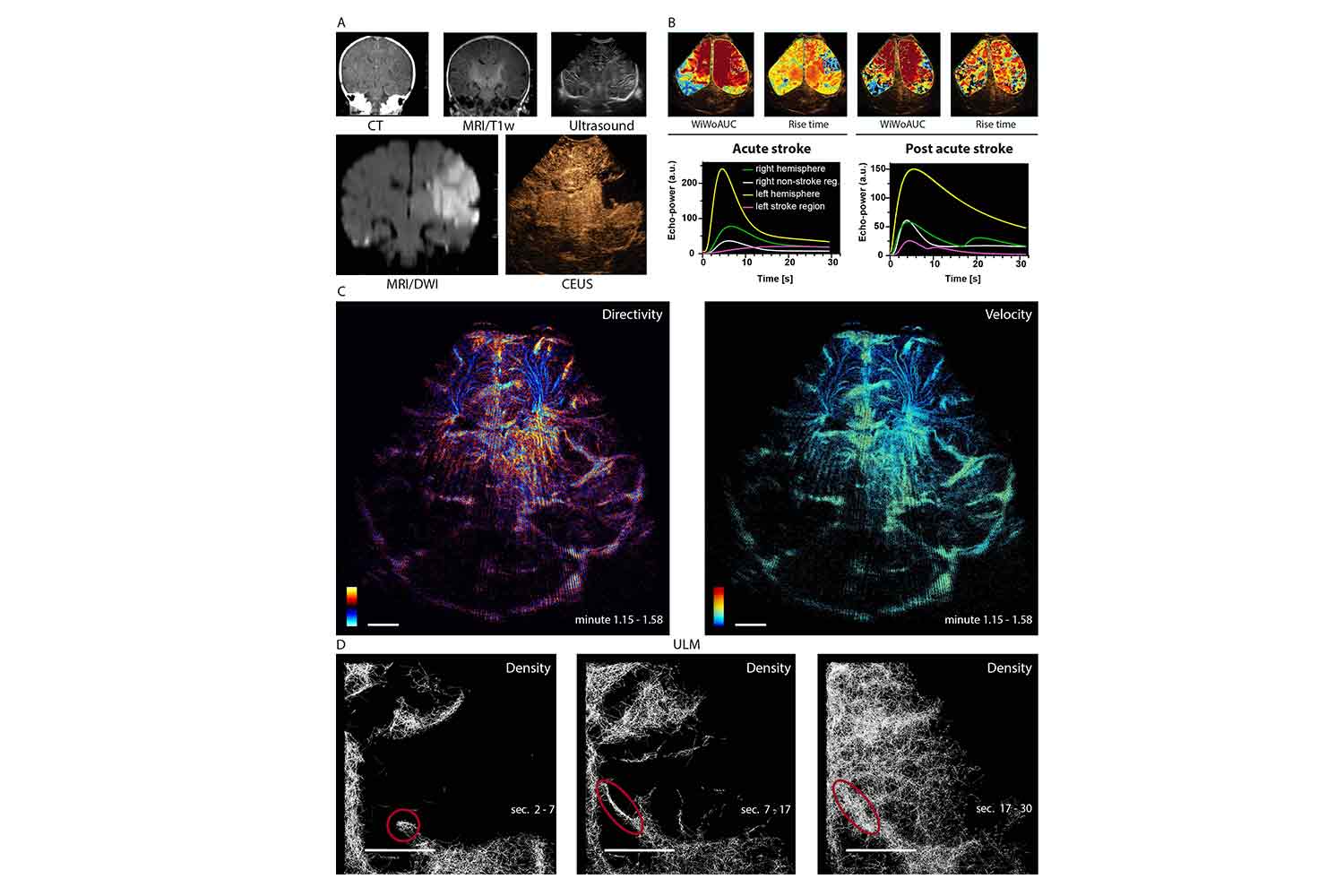Pioneering ultrasound method for detailed imaging of the newborn brain
New high-speed ultrasound devices combined with AI imaging can deliver high resolution images of the newborn brain. Researchers from Friedrich-Alexander-Universität Erlangen-Nürnberg are hoping to develop this method and explore potential applications. Stroke either before or directly after the birth and asphyhxia, which is a dangerous condition where the newborn is deprived of oxygen, are currently high on their list of priorities. The German Society for Ultrasound in Medicine (DEGUM) is funding the project with approximately 180,000 euros.
Research project at Uniklinikum Erlangen supports applications for neurological diseases such as neonatal stroke
Some newborns suffer a stroke either before or directly after birth. Mostly this is diagnosed with magnetic resonance tomography (MRI) scans. MRI scans for newborns are however particularly challenging and not all hospitals have MRI equipment available. New ultrasound technology could help physicians to reach a diagnosis quickly and ensure that the right therapy is provided as soon as possible.
In newborns, the bones of the skull are not yet fused together. This means that the head is not rigid, but can be slightly deformed so that it can pass through the birth canal more easily. “The unossified region – the fontanel – allows us to examine the brain of infants using ultrasound,” explains PD Dr. Dr. Adrian Regensburger, senior physician at the Department of Pediatrics and Adolescent Medicine, Uniklinikum Erlangen. “In adults, on the other hand, very little can be detected by ultrasound because the skull shields the brain.”
However, even in newborns, normal ultrasound devices often do not depict the vessels in the brain accurately enough for the images to be suitable for diagnosing a stroke. Regensburger is investigating a significantly improved method in conjunction with his colleagues PD Dr. Dr. Ferdinand Knieling and Dr. Gregor Hanslik, also senior physicians at the Department of Pediatrics and Adolescent Medicine. This involves injecting a few drops of contrast medium into the vein of the young patient. The liquid contains small gas bubbles, each the size of a red blood cell and appears as a light region on the ultrasound.
AI tracks the journey of the contrast agent bubbles through the brain
Appropriately trained algorithms can recognize individual contrast agent bubbles in the ultrasound film and track their journey through the brain. “This allows us not only to visualize the vessels, but also to precisely analyze where there are constrictions or blockages,” explains Regensburger. To make it easier for the AI, the scientists use high-speed ultrasound equipment. These do not record twenty images per second, as is usually the case, but up to three hundred and more. As a result, the bubbles only change their position very slightly between recordings. They are therefore much easier to track.
“In future studies, we also want to use a special transducer to generate three-dimensional images,” says the scientist. “By combining these measures, we can analyze the vessels in the brain and their condition in very high resolution.” The researchers recently published a paper in the journal Stroke, DOI see below, demonstrating the potential of this so-called Ultrasound Localization Microscopy.
In the DEGUM-funded project, they want to develop the procedure. They also want to investigate the extent to which it is suitable for diagnosing stroke quickly. “We hope that this will also allow us to treat stroke more quickly, for example by dissolving the blood clot causing the problem,” explains Regensburger.
Another focus is on asphyxia, a serious lack of oxygen after birth. For example, the researchers want to find out whether they can use their method to visualize the areas of the brain that suffer particularly severely from the deficiency. They also want to investigate how the brain reacts – for example, whether it increases blood flow to the affected regions and reduces the supply to other areas. “In this context, we are also interested in the extent to which we can derive possible therapeutic measures from mechanisms such as these in order to prevent permanent damage to the brain,” says the physician.
DOI: 10.1161/STROKEAHA.124.048390
Ultrasound localization microscopy (ULM) of perinatal ischemic stroke

A: Images of a newborn’s head in the frontal plane using computed tomography (CT), magnetic resonance imaging/diffusion-weighted imaging (MRI/DWI; reconstructed) and B-mode ultrasound. All imaging procedures showed an infarction of the left middle cerebral artery. For the diagnosis of the stroke region, diffusion-weighted MRI sequence and transfontanellar contrast-enhanced ultrasound (CEUS) were the superior methods.
B: The time-intensity curve analyzes the cerebral blood flow of the left and right hemisphere, the ischemic area and the corresponding area on the opposite side. Visualization of two calculated perfusion parameters (area under the curve during the wash-in and wash-out phase [WiWoAUC] and the rise time) within the affected regions. Imaging was performed during the acute and post-acute phases and shows an improvement in perfusion in the infarct area.
C and D: ULM of the whole brain (C) and time-resolved image of the infarcted area (D) during the acute phase. Shown are maps of directionality and velocity during the low flow phase (1.15-1.58 minutes after arrival of the first bubble), showing hyperperfusion of the left hemisphere. The stroke area was analyzed immediately after the arrival of the first microbubble and in the following time periods (2-7, 7-17 and 17-30 seconds) to visualize the remaining blood flow in the stroke area by time (circles). Scale bar: 1 cm.
Image: Stroke
Further information:
PD Dr. Dr. Adrian Regensburger
Department of Pediatrics and Adolescent Medicine
Phone: +49 9131 85-33118
adrian.regensburger@uk-erlangen.de
